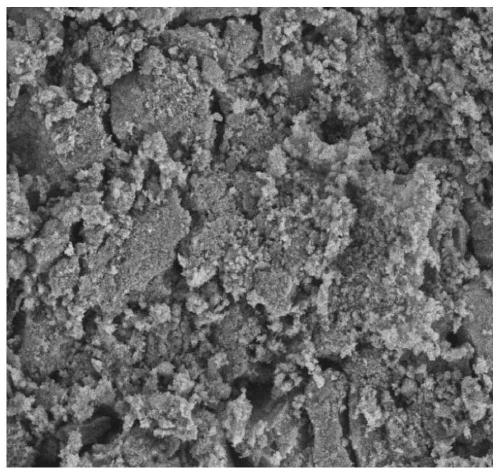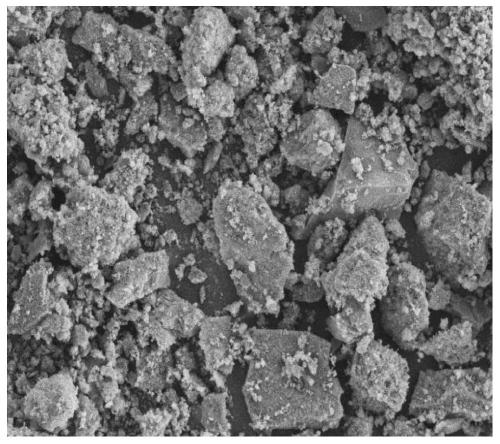Cobalt-based mesoporous material Co-TUD-1 catalyst and preparation method and application thereof
A TUD-1, cobalt-based mesoporous technology, applied in molecular sieve catalysts, chemical instruments and methods, physical/chemical process catalysts, etc., can solve problems such as slowness, product quality decline, and sulfite secondary pollution
- Summary
- Abstract
- Description
- Claims
- Application Information
AI Technical Summary
Problems solved by technology
Method used
Image
Examples
preparation example Construction
[0027] The present invention provides the preparation method of above-mentioned cobalt-based mesoporous material Co-TUD-1 catalyst, comprising the following steps:
[0028] (1) Mixing cobalt sulfate, ethyl orthosilicate, triethanolamine, tetraethylammonium hydroxide and water, standing and drying successively to obtain xerogel;
[0029] (2) performing hydrothermal treatment and calcination on the dry gel in sequence to obtain the cobalt-based mesoporous material Co-TUD-1 catalyst.
[0030] The invention mixes cobalt sulfate, ethyl orthosilicate, triethanolamine, tetraethylammonium hydroxide and water, stands still and dries in sequence to obtain dry gel. In the present invention, the mass ratio of ethyl orthosilicate, triethanolamine and tetraethylammonium hydroxide is preferably 8.82~10.78:6.633~8.107:3.182~3.889:2.8~11.8, more preferably 9.8:7.3744: 3.535:4.8; In the present invention, the purity of described cobalt sulfate is preferably > 99%, the purity of described ethyl...
Embodiment 1
[0038] Preparation of cobalt-based mesoporous material Co-TUD-1 catalyst with cobalt-silicon molar ratio of 8%:
[0039] Take 1.12gCoSO 4 ·7H 2 O (purity>99%) is dissolved in 3mL deionized water, is added dropwise in 10.729mL orthosilicate ethyl ester (purity>98%), uses magnetic stirrer to stir while adding dropwise, and 8.64g triethanolamine (purity is 85%) and 1.8g of deionized water were added dropwise to the above solution, and after stirring for 30min, 14.14g of tetraethylammonium hydroxide (purity was 25%) was added dropwise, and the mixed liquid was covered with plastic wrap and allowed to stand at room temperature for 24h, 100 Dry in a drying oven at ℃ for 24 hours to obtain the xerogel; put the xerogel in a polytetrafluoroethylene reactor at 180℃ for 8 hours, and finally calcinate it in a muffle furnace at 600℃ for 10 hours at a heating rate of 1℃ / min to obtain The cobalt-based mesoporous material Co-TUD-1 catalyst is denoted as 8% Co-TUD-1.
[0040]Gained 8% Co-TU...
Embodiment 2
[0042] The amount of cobalt sulfate was changed so that the molar ratio of cobalt to silicon was 10%, and the rest of the method was the same as in Example 1 to obtain a cobalt-based mesoporous material Co-TUD-1 catalyst, which was recorded as 10% Co-TUD-1.
[0043] Gained 10% Co-TUD-1 is carried out SEM scanning electron microscope test, and obtained result is as follows figure 2 shown by figure 2 It can be seen that 10% Co-TUD-1 also has a sponge-like porous structure, and its specific surface area is 400-1000m 2 / g, the pore diameter is 2.5-25nm. Among them, the silica skeleton is an amorphous structure, which is in an amorphous state and lacks a long-range ordered mesoporous structure.
PUM
| Property | Measurement | Unit |
|---|---|---|
| Specific surface area | aaaaa | aaaaa |
| Aperture | aaaaa | aaaaa |
Abstract
Description
Claims
Application Information
 Login to View More
Login to View More - R&D
- Intellectual Property
- Life Sciences
- Materials
- Tech Scout
- Unparalleled Data Quality
- Higher Quality Content
- 60% Fewer Hallucinations
Browse by: Latest US Patents, China's latest patents, Technical Efficacy Thesaurus, Application Domain, Technology Topic, Popular Technical Reports.
© 2025 PatSnap. All rights reserved.Legal|Privacy policy|Modern Slavery Act Transparency Statement|Sitemap|About US| Contact US: help@patsnap.com



